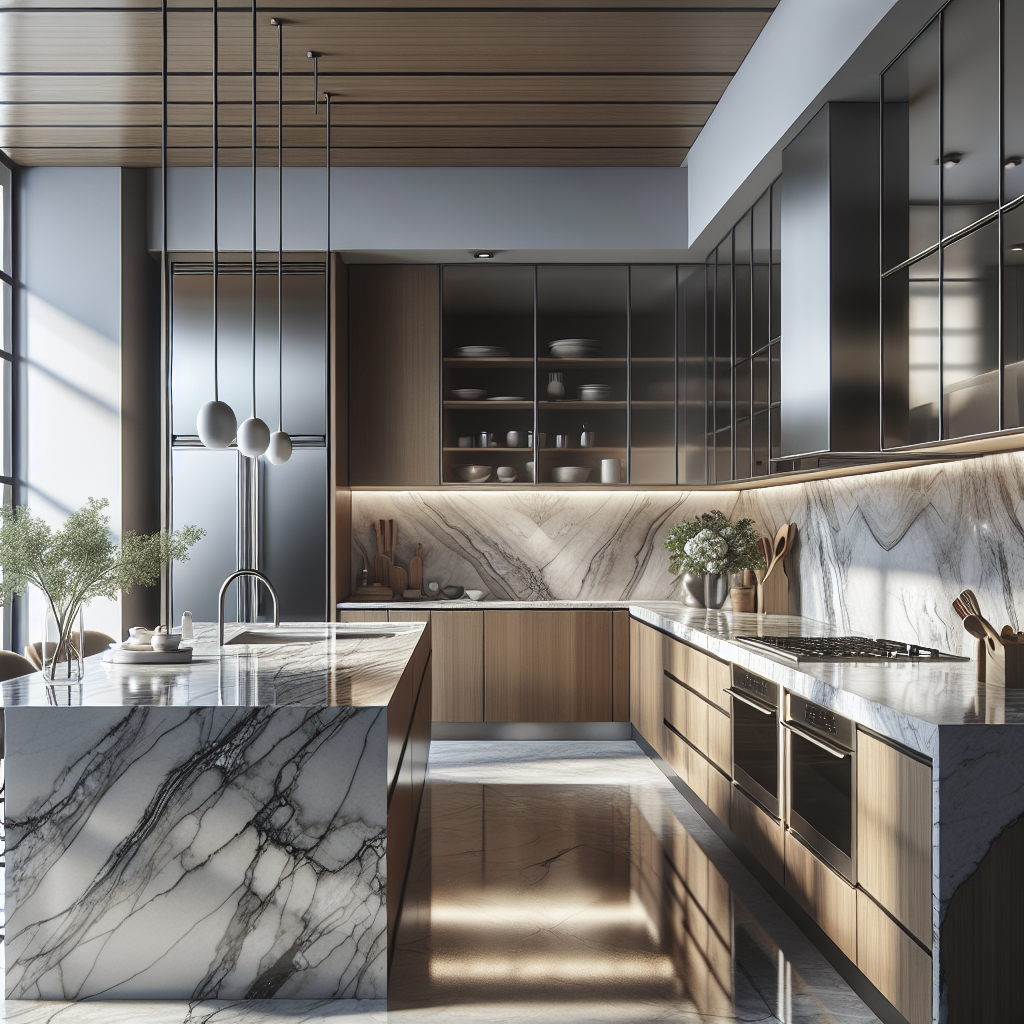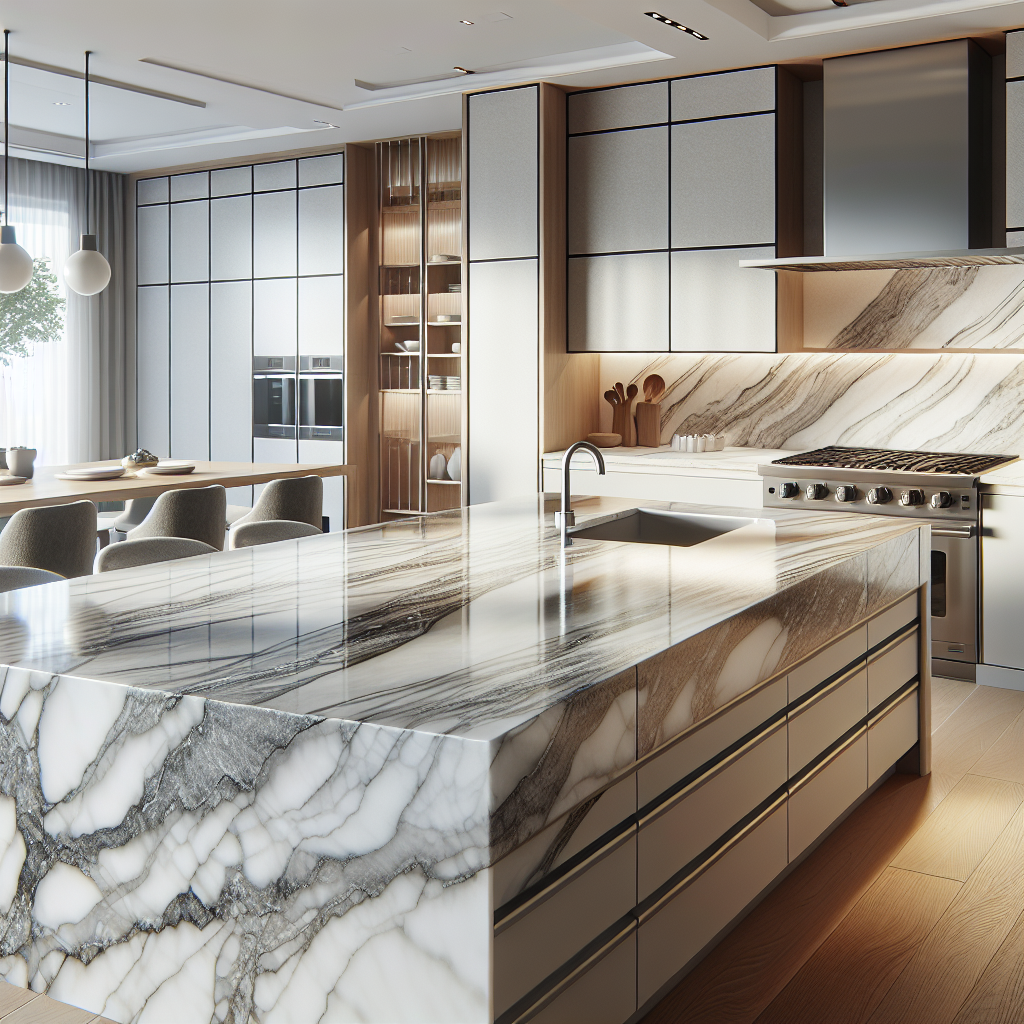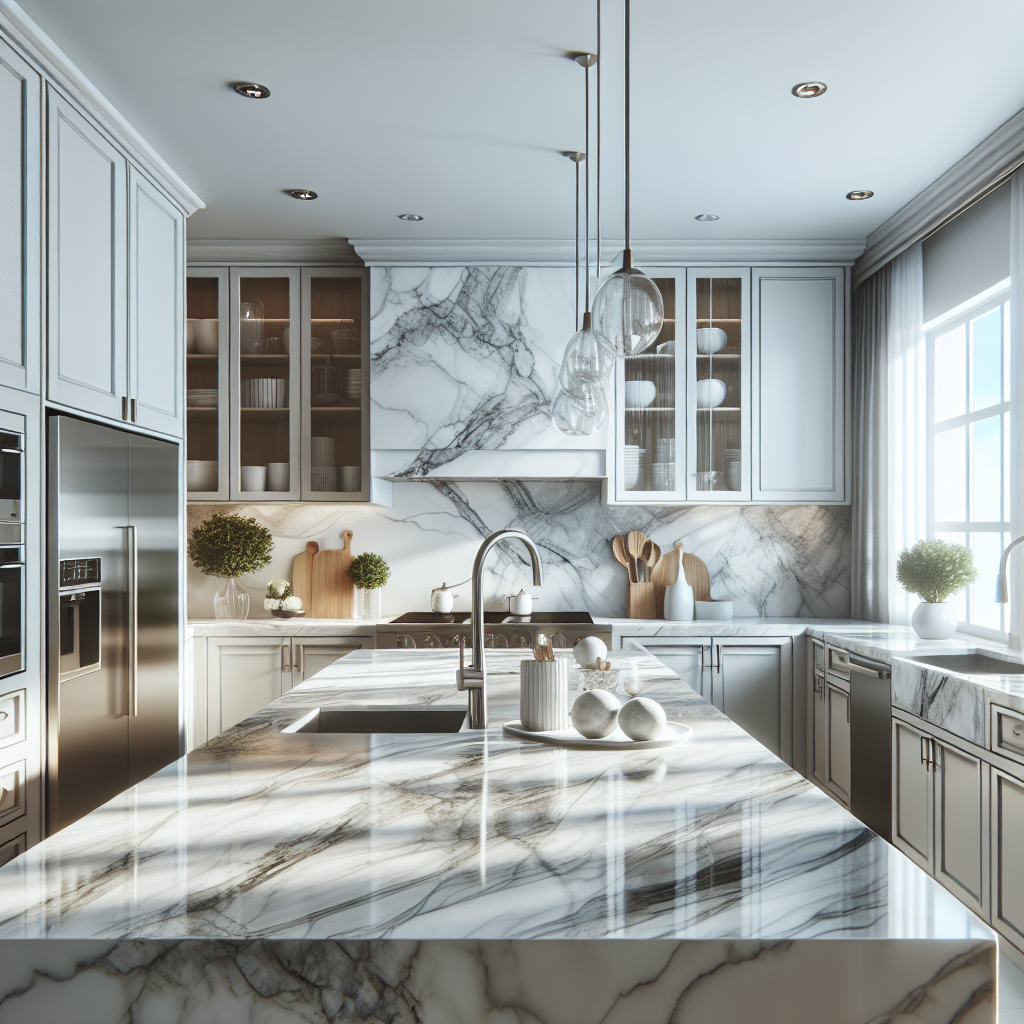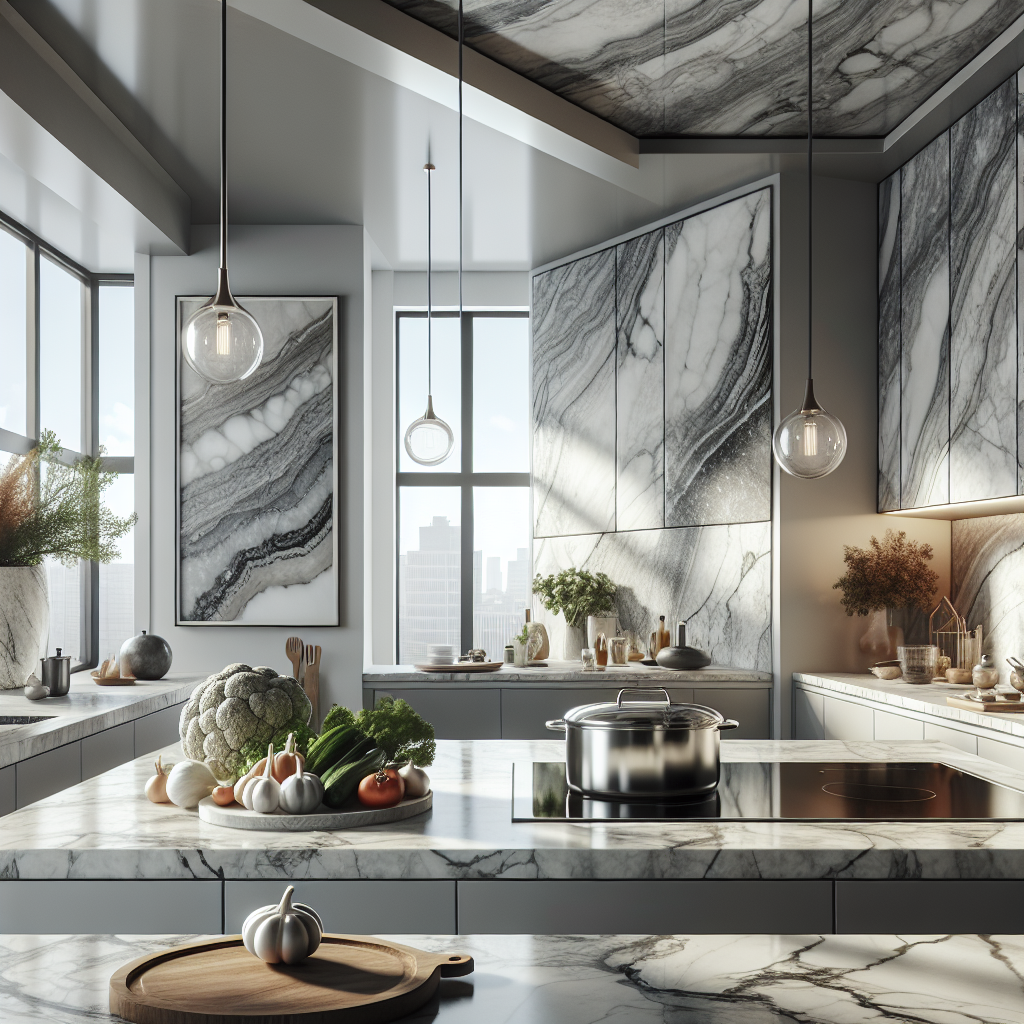Marble counters have long been celebrated for their timeless elegance and unmatched beauty. These luxurious surfaces can transform any kitchen into a sophisticated space, making them a popular choice among homeowners and designers alike. Marble counters are not only aesthetically pleasing but also offer a range of practical benefits that make them a worthwhile investment.
One of the key reasons why marble counters are highly sought-after is their unique veining and natural patterns. Each slab of marble is one-of-a-kind, ensuring that your countertop is a unique masterpiece that cannot be replicated. This natural stone comes in various shades, including classic white, bold black, and a variety of other colors, allowing you to find the perfect match for your kitchen’s design.
In addition to their visual appeal, marble counters are known for their durability and heat resistance. They can withstand high temperatures, making them an excellent choice for avid cooks and bakers. However, it’s essential to be aware that marble is a porous material, which means it can be susceptible to staining if not properly sealed and maintained.
To truly appreciate the elegance and practicality of marble counters, it’s essential to see and feel the material in person. At Absolute Marble and Granite, we offer a wide selection of high-quality marble slabs, each carefully sourced to ensure exceptional quality. Call us today at (954) 781-7370 for a free quote or visit our website at Absolute Marble and Granite to explore our stunning marble collection.
Benefits of Marble Counters

Choosing marble counters for your kitchen brings a myriad of benefits that go beyond their stunning appearance. Here are some of the key advantages of opting for marble countertops:
- Timeless Aesthetic: Marble has been used in architecture and design for centuries, and its classic elegance never goes out of style. Its natural veining and unique patterns make each piece a work of art, adding a sophisticated touch to any kitchen.
- Durability: Marble is a strong and long-lasting material. When properly cared for, marble counters can last for decades, making them a worthwhile investment.
- Heat Resistance: One of the standout benefits of marble is its ability to withstand high temperatures. This makes it an ideal surface for cooking and baking, as hot pots and pans can be placed on the counter without causing damage.
- Cool Surface: Marble remains cool to the touch, which is particularly beneficial in warmer climates. This feature also makes it an excellent choice for baking enthusiasts, as the cool surface is perfect for working with dough and pastries.
- Increased Home Value: Installing marble counters can significantly boost the value of your home. Their luxurious appeal and timeless beauty are attractive features for potential buyers, making your property more desirable.
While marble counters do require some maintenance to keep them looking their best, the benefits they offer make them a popular choice for homeowners seeking a blend of beauty and functionality.
Maintenance Tips for Marble Counters

Maintaining the pristine look of your marble counters requires some dedication, but with the right care, they can remain beautiful for years to come. Here are some essential maintenance tips to ensure your marble counters stay in top condition:
- Regular Cleaning: Use a soft cloth and a gentle, pH-neutral cleaner to wipe down your marble counters daily. Avoid abrasive cleaners or pads, as they can scratch the surface. A mix of warm water and mild dish soap is often sufficient for everyday cleaning.
- Seal the Surface: Marble is a porous material, which means it can absorb liquids and stains. To prevent this, regularly apply a high-quality marble sealer. Depending on the type of marble and the sealer used, this might need to be done every 6 to 12 months.
- Spill Management: Quickly clean up any spills, especially acidic substances like lemon juice, vinegar, or wine, which can etch the marble. Blot the spills instead of wiping them to prevent them from spreading.
- Avoid Heavy Impact: Although marble is durable, it can chip or crack under heavy impact. Be mindful when handling heavy pots and pans near your marble counters.
- Use Cutting Boards: Always use cutting boards when preparing food to avoid scratching the marble surface. This also helps to prevent potential staining from ingredients like beets or berries.
- Trivets and Mats: Place trivets or mats under hot cookware to protect the marble from thermal shock, which can cause cracks or discoloration.
By incorporating these maintenance practices into your routine, you can preserve the elegance and functionality of your marble counters, ensuring they remain a stunning feature in your kitchen.
Design Options for Marble Counters

When it comes to design options for marble counters, the choices are both varied and exquisite, allowing homeowners to find the perfect fit for their kitchen aesthetics. Marble is celebrated for its unique veining patterns and a wide range of colors, making it a versatile choice for any design preference. Here are some popular design options:
- Classic White Marble: Timeless and elegant, white marble such as Carrara, Calacatta, and Statuario are highly sought after. These options offer a clean, bright look with distinctive grey veining that adds a touch of sophistication to any kitchen.
- Dark Marble: For a bold and dramatic effect, consider dark marble varieties like Nero Marquina or Black Marquina. These options provide a striking contrast, especially when paired with lighter cabinetry or stainless steel appliances.
- Colorful Marble: Beyond the traditional white and black, marble also comes in an array of colors including green, pink, and blue. Stones like Verde Alpi and Rosso Levanto introduce vibrant hues to your kitchen, creating a unique and personalized space.
- Bookmatched Marble: This design technique involves placing two slabs of marble side by side to create a mirror image, resulting in a stunning symmetrical pattern. Bookmatching is perfect for creating a focal point on larger surfaces like kitchen islands.
- Honed vs. Polished Finish: The finish of the marble can significantly affect its appearance. A polished finish offers a glossy, reflective surface that enhances the marble’s color and veining, while a honed finish provides a matte, smooth surface that is less prone to showing scratches and etching.
- Edge Profiles: The edge profile of your marble countertop can also add to its overall design. Options range from simple, straight edges to more ornate profiles like ogee or bullnose, allowing for further customization to match your kitchen’s style.
By exploring these design options, you can select marble counters that not only meet your functional needs but also elevate the visual appeal of your kitchen. The versatility and natural beauty of marble make it an outstanding choice for those looking to create a luxurious and timeless kitchen space.
Comparing Marble to Other Materials
When choosing the perfect countertop material, it’s essential to compare marble counters to other popular options like granite, quartz, and porcelain. Each material has its unique characteristics, benefits, and drawbacks, making it crucial to understand how marble stands out.
Marble vs. Granite: Both marble and granite are natural stones, but they differ significantly in appearance and properties. Marble is known for its elegant veining and softer, more porous nature, which can be more susceptible to staining and etching. Granite, on the other hand, is denser and less porous, making it more resistant to scratches and stains. However, marble’s unique beauty and timeless appeal often make it the preferred choice for those seeking a luxurious look.
Marble vs. Quartz: Quartz countertops are engineered from natural quartz crystals combined with resins and pigments. This makes quartz highly durable, non-porous, and resistant to staining and scratching. While quartz offers a wide range of colors and patterns, it lacks the natural veining and uniqueness of marble. Homeowners who prioritize low maintenance and durability might prefer quartz, but those who value natural beauty and elegance often choose marble.
Marble vs. Porcelain: Porcelain countertops are made from a type of ceramic that is highly durable and resistant to heat, scratches, and stains. Porcelain can mimic the look of natural stones, including marble, but it doesn’t offer the same authenticity. While porcelain is an excellent choice for high-traffic areas due to its durability, it may not have the same luxurious feel as genuine marble.
Cost Considerations: The cost of marble can vary based on the type and quality, but it is generally more expensive than materials like quartz and porcelain. Granite’s cost can be comparable to marble, depending on the specific stone. While the initial investment in marble might be higher, its timeless beauty and potential to increase property value can justify the expense for many homeowners.
By understanding the differences between marble and other countertop materials, you can make an informed decision that aligns with your aesthetic preferences, lifestyle, and budget. Whether you prioritize durability, maintenance, or natural beauty, there is a countertop material that perfectly suits your needs.
Choosing the Right Marble Countertop

Selecting the appropriate marble countertop for your kitchen involves several considerations, ensuring that the final choice aligns with your aesthetic vision and practical needs. Here are some key factors to keep in mind when choosing the right marble countertop:
1. Color and Veining: Marble comes in a variety of colors, from classic whites and greys to more exotic hues like greens, reds, and blacks. The veining patterns in marble are unique to each slab, contributing to its natural elegance. Consider the overall color scheme of your kitchen and select a marble type that complements your design.
2. Finish Options: Marble countertops are available in different finishes, each offering a distinct look and feel. A polished finish delivers a high-gloss, reflective surface that enhances the stone’s color and veining. A honed finish, on the other hand, provides a matte, smooth texture that is less prone to showing scratches and etching. Choose a finish based on your preference for appearance and maintenance.
3. Thickness and Edge Profiles: The thickness of the marble slab can impact both the cost and the visual appeal of your countertop. Standard thicknesses range from 2 cm to 3 cm. Additionally, the edge profile you select – whether it’s a simple eased edge or a more intricate ogee – can add a personalized touch to your countertop.
4. Maintenance Requirements: Marble is a more porous material, which means it requires regular sealing to prevent staining and etching. Be prepared for a bit more maintenance compared to other materials, and consider whether you’re willing to invest the time and effort needed to keep your marble countertops looking pristine.
5. Budget Considerations: Marble can be a significant investment, but it can also add substantial value to your home. Evaluate your budget and decide how much you are willing to spend on your countertops. Remember that the quality and rarity of the marble type will influence the price.
By taking these factors into account, you can choose a marble countertop that not only enhances the beauty of your kitchen but also fits your lifestyle and budget. If you need expert guidance on selecting the perfect marble countertop, call us today at (954) 781-7370 for a free quote!
